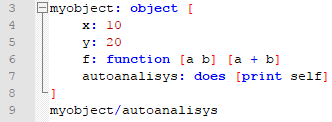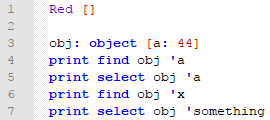Objects
An object is a container that groups data and/or functions within one variable. To access an object's attribute in Red, we use a slash (/) as a separator. This is unusual as most languages use a dot, but once you get used to it, it seems more intuitive as it is similar to a path.
Creating an object:
 make object! , context & object
make object! , context & object
You may use make object! object or context to create an object. They are the same command. object and context are just shortcuts to make object!.

10
20
8
John
3333-3333
>>
Evaluation is done only when creating an object! Notice that the print command in the code below is not executed when the object is accessed:
>> myobject: object [print "hello" a: 1 b: 2]
hello
== make object! [
a: 1
b: 2
]
>> myobject/a
== 1
>>
Self reference:
When an object must do a reference to itself, we use a special keyword named self :

x: 10
y: 20
f: func [a b][a + b]
autoanalisys: func [][print self]
>>
Cloning an object and inheritance:
Simply assigning an object to another only creates a copy of the pointer to that object. If the original changes, the second also changes:
>> a: object [x: 10]
;lines of the console deleted for the sake of clarity.
>> b: a
;lines of the console deleted for the sake of clarity.
>> a/x: 20
== 20
>> b/x
== 20 ;changed too!
>>
To make a true copy of an object, we use the word copy:
>> a: object [x: 10]
;lines of the console deleted for the sake of clarity.
>> b: copy a
;lines of the console deleted for the sake of clarity.
>> a/x: 20
== 20
>> b/x
== 10 ;NO change! b is a true copy.
>>
If we want to create a new object that inherits the first object , we use: make <original object> <new specifications>:

x: 3
y: 12
>>
 find & select - for objects
find & select - for objects
find simply checks if the field exists, returning true or none .
select does the same checking, but if the field exists, returns its value.

true
44
none
none
>>
Notice that both look for the word (indicated by the ' symbol preceding it), not the variable itself. The variable would be accessed by a simple path like obj/a.